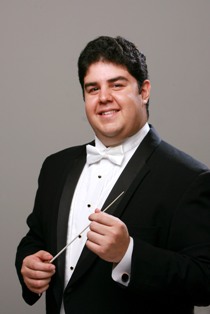
Munoz, Chee-Yun Brighten Drab Night

Tito Munoz is a young man on his way.
The native New Yorker, who joined Eric Dudley as one of two assistant conductors with the Cincinnati Symphony Orchestra last fall, made his CSO subscription debut Saturday night at Music Hall.
Munoz, 23, whose official CSO debut was leading the Fine Arts Fund Sampler concert Feb. 11, stepped in handsomely for previously announced guest conductor Krzysztof Penderecki, who is recovering from surgery.
Munoz wore tux and tails this time, bowing in before an audience that also welcomed returning guest artist, violinist Chee-Yun,
The Korean born star, a former Cincinnati resident and adjunct faculty member at the University of Cincinnati College-Conservatory of Music, received a warm reception in Bruch's popular Violin Concerto in G Minor.
Munoz lit up the drab, rainy night with music shimmering in color, Dukas' "Sorcerer's Apprentice," Stravinsky's "Firebird" Suite (1919) and the Overture to Mozart's "Don Giovanni." Trained at the American Academy of Conducting at the Aspen Festival in Colorado, Munoz led with uncommon poise and presence, his gestures neatly tailored to the music, both in size and character. He proved a sympathetic collaborator as well, closely matching Chee-Yun's temperament in the Bruch.
Now based in Dallas, where she has an appointment at Southern Methodist University, Chee-Yun made a glamorous entrance in a low-cut, slit-leg raspberry gown. Then she got down to business, spinning a sorbet-sweet line in the opening bars of the concerto without a touch of overheatedness.
There was something conversational, almost confidential about her Adagio, which exuded tenderness, while she flaunted her formidable technique in the brio finale. There were occasional intonation problems (a clunker, quickly corrected, on a shift of position in the Adagio and a lapse or two in the finale) but these seemed due more to nerves than anything else.
Munoz conjured his wizards well in Dukas' "Sorcerer" and Stravinsky's "Firebird." The Merlin-like master of the Dukas emerged "misterioso," setting the scene for the apprentice's mischief (Mickey Mouse in "Fantasia"). There would have been a perfect moment as the sorcerer departed had not a loud cough broken the silence just as the bassoons (brooms) were coming to life. A
lengthening of the tempo gave the sorcerer added presence as he returned to restore order to his flooded laboratory.
Kastchei, the wizard in "Firebird," is an evil ogre whose spell is broken by a prince with the help of the firebird. The vivid score got a performance to match, gently romantic in "Round of the Princesses," savage in Kastchei's "Infernal Dance," majestic in the finale, with fine solos by the CSO principals, including principal hornist Elizabeth Freimuth. If there was a downer, it was Music Hall, whose size (jumbo) routinely forestalls a more intimate concert experience, both aurally and visually.
(first published in The Cincinnati Post Feb. 26, 2007)